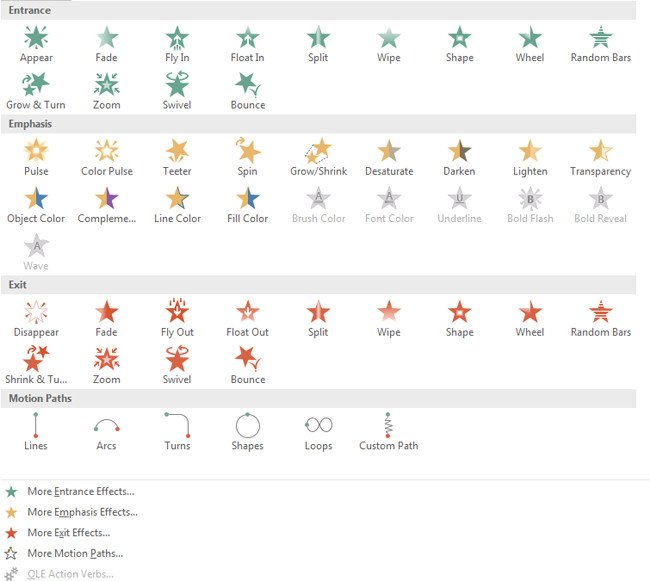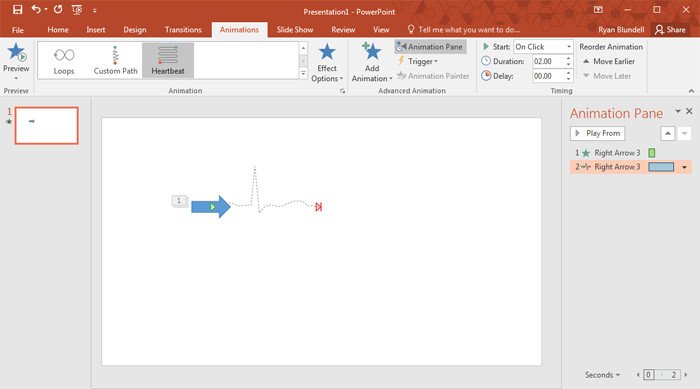Animations in Powerpoint 2016
How to create animations in PowerPoint 2016
Your presented data may be deathly boring
but your presentation of it doesn't have to be. Animations can be used to bring
a bit of life to your report.
Let's face it, not everything you share
will be tantalizing to keep the attention of your audience. Just as transition
effects or images can complement the information, animations help to increase
the "wow" factor.
Here's how you can add animation effects to
text, shapes, and images.
How to add and remove animation effects in
PowerPoint
How to edit and manage animation effects in
PowerPoint
How to use motion path animation effects in
PowerPoint
Animation effects can be applied to text,
shapes, and objects on any slide in PowerPoint 2016. When you explore the
number of animation effects, you will notice that they are grouped into four
types. Let's see what they are and how to use them.
Entrance — This group of effects serves to
introduce text or objects into a slide during a presentation.
Exit — This group helps to mark the end of
the text or object's time on the slide.
Emphasis — This group provides you the
option to draw attention to text or objects. It can be used to highlight
important details.
Motion Paths — This group allows you to
move text and objects along a predetermined path. These can be used as
transitions of sorts on a slide.
With the exception of Motion Paths, most of
the animation types contain subgroups of effects. They include Basic, Subtle,
Moderate and Exciting effects.
How to add and remove animation effects in
PowerPoint

How to add an animation effect to text or
objects
1. Select the text or object you need to
animate
2. Click on the Animations tab in the
navigation ribbon.
3. Click Add Animation.
4. Select an animation effect from the list.
You can apply more than one effect to the
same object. This can only be done by clicking on Add Animation. If you try to
add another animation by any other means, you will only replace the previous
effect.
The default naming convention for animation
effects could be somewhat confusing to look at. The ability to rename
animations to clarify target objects is available in the Selection pane from
the Home tab. Double-click on a name to be able to edit it.
How to remove an animation effect
1. Select Animation Pane from the Advanced
Animation group.
2. Select the animation effect from the pane
on the right side.
3. Click the Down Arrow to open a drop-down
list.
4. Select Remove.
How to edit and manage animation effects in
PowerPoint

How to change the order of the animation
effects
1. Click the Animations tab in the navigation
ribbon.
2. Select the Animation pane from the Advanced
Animation group.
3. Select the Animation you wish to move in
the Animation pane.
4. Select either the up and down arrow, next
to the Play From button, to move the animation earlier or later in the
sequence.
How to set the start time and duration of
an effect
1. Navigate to the Animation pane.
2. Select an animation effect from the list.
3. Click the Down Arrow to the right of the
effect listing.
4. Select Timing from the drop-down list.
5. Select Start from the Timing tab to select
an option.
6. Choose a value under the Delay option.
7. Choose the length of the animation effect
under the Duration section.
By adjusting the duration, you are altering
the speed of the animation, which can potentially alter the impact the effect
has on the audience.
How to activate an animation effect by
clicking on it
1. Click on the object or text in question.
2. Click on the Animations tab.
3. Add the animation as described in How to
animate text or objects in PowerPoint 2016.
4. Locate the Advanced Animation group.
5. Select Animation pane.
6. Select the object or text to be triggered
with a click.
7. Select Trigger from the Advanced Animation
group.
8. Select On Click from the drop-down.
9. Select the object to confirm.
How to begin an animation during audio and
video content
1. Select the audio or video clip on a slide.
2. Click Play from the media controls.
3. Click Pause where you want to add a
bookmark.
4. Locate the Playback tab in the Video Tools
section.
5. Select Add Bookmark from the Bookmark
group.
6. Select the Animation tab.
7. Select Advanced Animation.
8. Select Animation pane.
9. Select an animation effect.
10. Select Trigger under Advanced Animation.
11. Select On Bookmark from the drop-down list.
12. Choose the bookmark you have set.
How to Repeat and Rewind an animation
effect
1. Select the Animations tab.
2. Select the Show Additional Effect Options
icon.
3. Select the Timing tab.
4. Select an option from the Repeat drop-down.
5. Click the Rewind when done playing
checkbox.
How to use motion path animation effects in
PowerPoint
How to add a motion path to text or objects
1. Select the Animations tab.
2. Click Add Animation under the Advanced
Animation group.
3. Navigate to the Motion Path group of
effects.
4. Select a path.
If you were to select the Custom Path
option, you will be required to draw out the path to be taken. Click and drag
to create a visible, freehand path or just point and click to create lines with
connection points. Double-click the left mouse button to mark the end of the
path and see a preview of the movement.
How to modify a motion path
1. Select Effect Options in the Animation
group.
2. Select from the presented motion
alternatives to change the path.
3. Navigate to the Path group in the
drop-down.
4. Click on Edit Points.
5. Click on any points on the path and drag to
a new location.
6. Click Preview to see the revised animation
in action.

Comments
Post a Comment